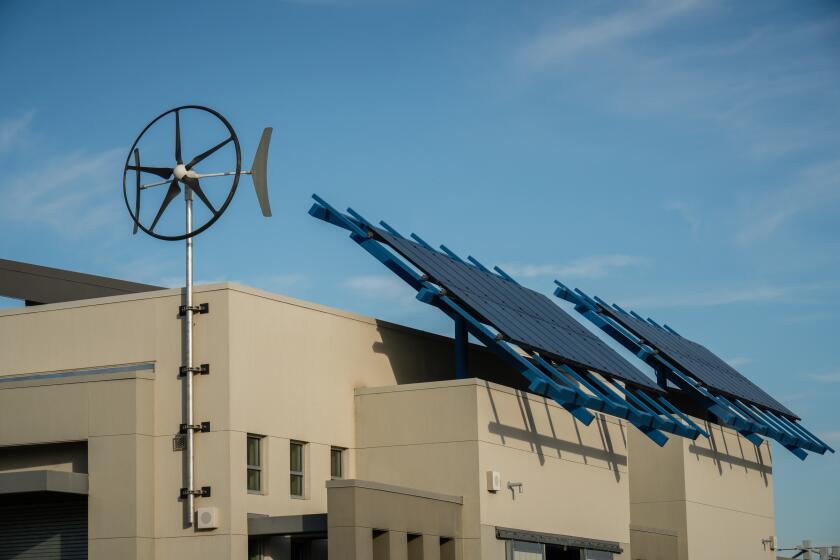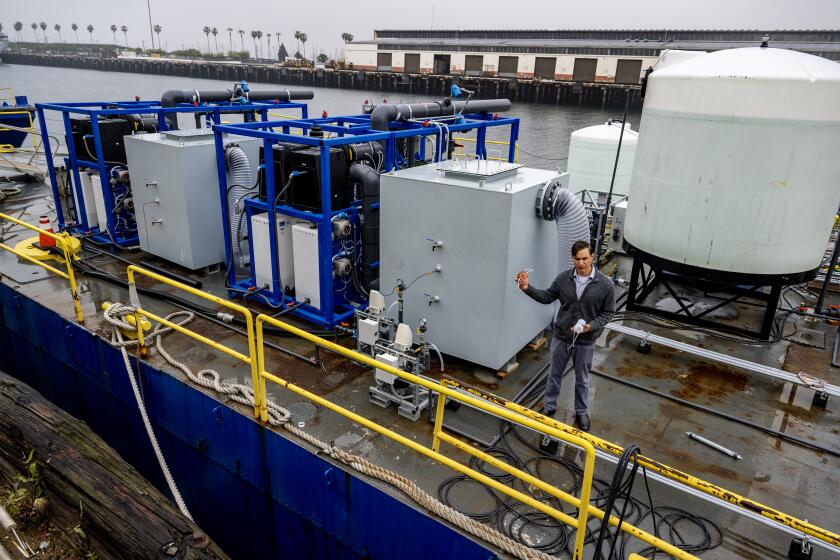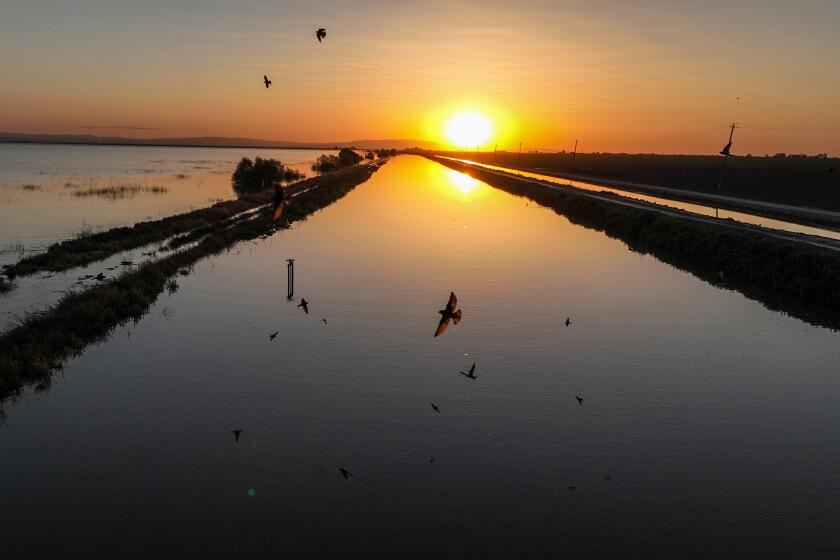
- Share via
In the opening chapter of “The Ministry for the Future,” science-fiction author Kim Stanley Robinson details a calamitous heat wave that kills almost all the residents of a small town. In another chapter, he imagines a catastrophic flood that wipes out Los Angeles.
The late Octavia Butler described a Southern California reeling from years of drought in “Parable of the Sower,” and Paolo Bacigalupi writes about a near-future Southwest that’s also been devastated by drought.
Sci-fi writers have long conceived worlds in which extreme weather events upend the lives of its inhabitants, but with every passing, warming year, their scenarios feel more prophetic.
Last September, record-shattering temperatures nearly broke the state’s power grid, and according to a Times investigation, extreme heat waves are killing more Californians than official records show. In the winter, after the driest three-year period on record that dried up wells and forced farmers to fallow fields, atmospheric river storms pummeled the state. Farms flooded. Levees failed.
For decades, scientists have warned us that human-caused climate change will produce a growing number of weather catastrophes. But as the impact of global warming unfolds across the world, events once expected to happen decades from now are already here.
If the Golden State is going to lead the world toward a better, safer future, our political and business leaders — and the rest of us — will have to work harder to rewrite the California narrative. Here’s how we can push the state forward.
A new study warned that burned areas in California could increase up to 52% by 2050 relative to the last several decades. But “megafires” in the state scorched about 50% more land in 2020 compared with 2018, the state’s biggest year for wildfires before that.
Dozens of people died. Thousands of structures were destroyed. The carbon pollution from the 2020 wildfires effectively negated nearly 20 years of state greenhouse gas emission reductions. Climate change is also aggravating air pollution, exacerbating inequalities for low-income, non-white and other marginalized communities.
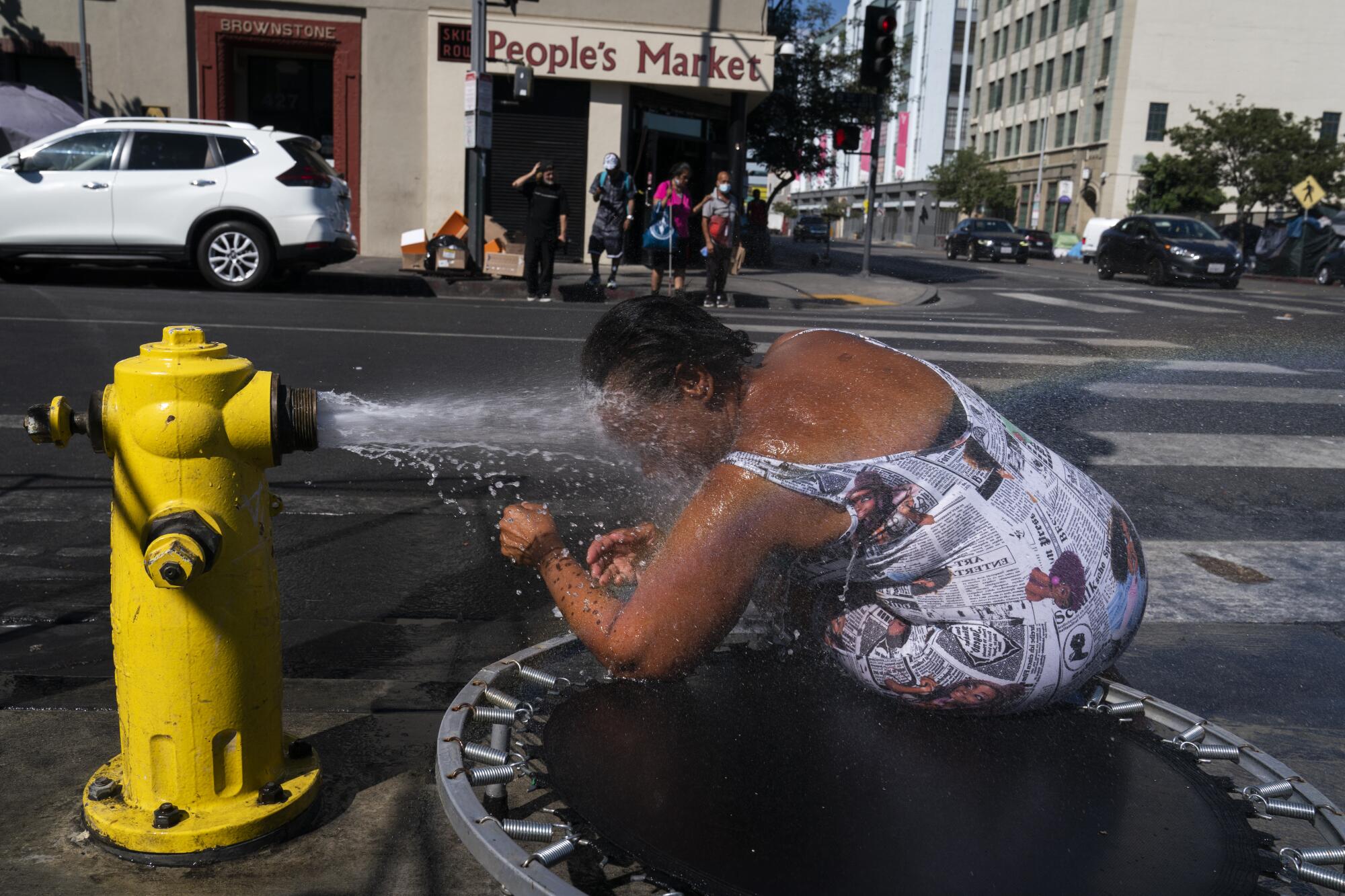
“The simple equation is climate change, warmer atmosphere, more intense rain, more pollution, more problems but also major catastrophic infrastructure damage,” said Stefanie Sekich, senior manager of Surfrider Foundation’s coast and climate initiative. Just last year, coastal erosion temporarily halted a scenic train route along the California coast, and land subsidence — a result of overpumping of groundwater driven by worsening droughts — has damaged canals, aqueducts and roads in the Central Valley.
“I can’t stress enough the importance of people starting to wake up to the fact that these extreme weather events are now here, whereas maybe five to 10 years ago, especially on the West Coast, they weren’t as prevalent,” she said. “And now they’re here, they’re overwhelming, and they’re only going to get worse.”
Let’s embrace the wildflower superblooms, abundant snowfall and roaring rivers while we’ve got them.
Although experts agree that the consequences of global warming will inevitably unfold over the next two to three decades, what happens beyond that will, to a great extent, depend on actions today.
California officials are making efforts to adapt to a changing climate and to mitigate worst-case projections. In 2021, Gov. Gavin Newsom signed a $15-billion package to fight and prepare for global warming.
In 2022, the state passed nearly 40 climate change laws aimed at slashing greenhouse gas emissions, Sekich said. Among them was legislation requiring all new vehicles sold in California to be zero-emission or plug-in hybrids by 2035, and another requiring a combination of renewable and zero-carbon sources to make up 90% of statewide electricity sales by 2030 and 95% by 2035.
California is “absolutely moving in the right direction” toward becoming more resilient and sustainable, said Alex Hall, a professor at UCLA’s Institute of the Environment and Sustainability. At the moment, he warned change isn’t happening on a scale that’s large enough to make a meaningful difference — but he has hope.
Campuses are prime spots for solar power. Teachers can also prepare kids for a climate-friendly future, a new report argues.
“I think the fact that we’re thinking about these things so deeply, and that we have examples of challenges where we have made a start on identifying the underlying problems, and building the infrastructure to generate solutions, that we now have experiences, that’s the foundation that you need to make more profound change at scale,” Hall said.
Here’s a snapshot of projections for California’s “big five climate threats,” what’s being done, and where we’re falling short:
Extreme heat
Perhaps the most devastating impact of a warming planet can be seen in extreme heat events. California suffered its worst heat wave ever less than a year ago, and the state’s six warmest years have all occurred since 2014.
A 2021 investigation published by the Los Angeles Times found that California chronically undercounts heat-related deaths. In Los Angeles, extreme heat is the city’s biggest climate threat and greatest cause of climate-related deaths and hospital visits.
By 2050, daily maximum average temperatures in California are expected to rise by 4.4 to 5.8 degrees, and heat waves in cities could cause two to three times more heat-related deaths.
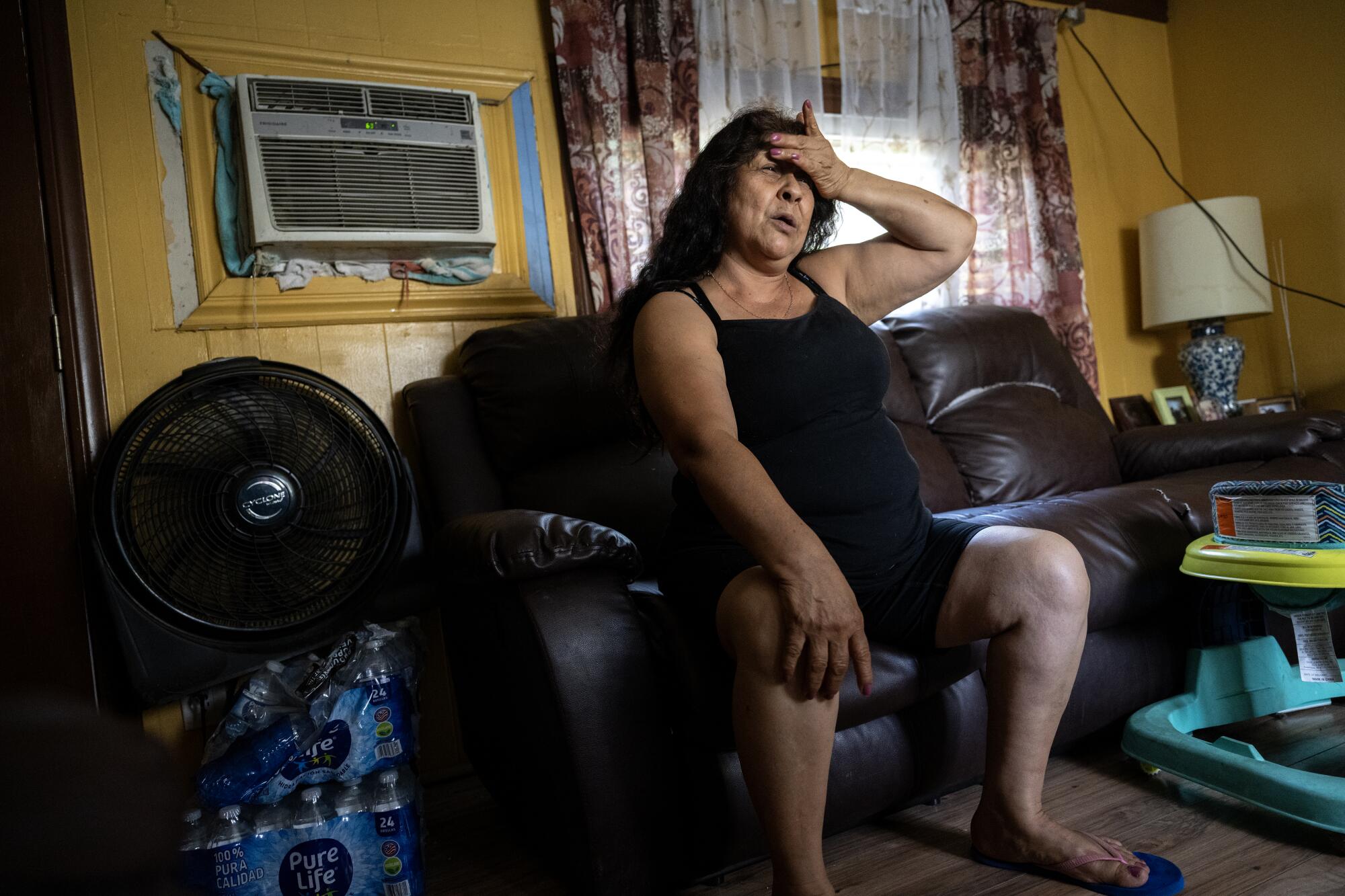
Extreme heat that can adversely impact human health is projected to last two weeks longer in the Central Valley and will happen four to 10 times more frequently around the Northern Sierra region, according to a state report. By the late century, state temperatures are projected to increase by 5.6 to 8.8 degrees, with the greatest increase expected if greenhouse gas emissions remain unchanged.
Climate change in the form of increasingly frequent natural disasters will likely cut into our savings over time.
California has attempted to respond to those imminent threats. Last year, Newsom announced the state’s Extreme Heat Action Plan with the goal to protect Californians from rising temperatures.
In addition, Los Angeles appointed its first-ever chief heat officer, Marta Segura, who said she’s putting an equity lens on climate solutions. She’s working to identify neighborhoods where cooling centers can save lives, and she’s making plans to plant trees and preserve existing ones as well as install shade structures and hydration stations in public spaces.
Segura said that targeting the most vulnerable communities could maximize investments and results but admitted that the city needs a sustainable funding source to execute its top-priority projects. Segura was given $1 million in allocated funds when she was appointed.
As for the rest of the state, she said cities need to share a unified vision “of creating healthier, thriving communities, avoiding preventable deaths and hospitalizations, and ensuring that they know that their primary role is to avoid those disaster scenarios.”
“It’s really important for cities to understand that,” Segura said, “and then to understand that it’s going to be this equity lens that’s going to help large cities like Los Angeles, because that’s where we will see the most improvement, the most change and most regional impact.”
Wildfires
Studies have warned that wildfires will scorch an increasing number of acres in California in the coming years.
If greenhouse gas emissions keep rising, the average area of land burned will increase 77% by 2100, and wildfire insurance will rise about 18% by 2055, according to California‘s Fourth Climate Change Assessment.
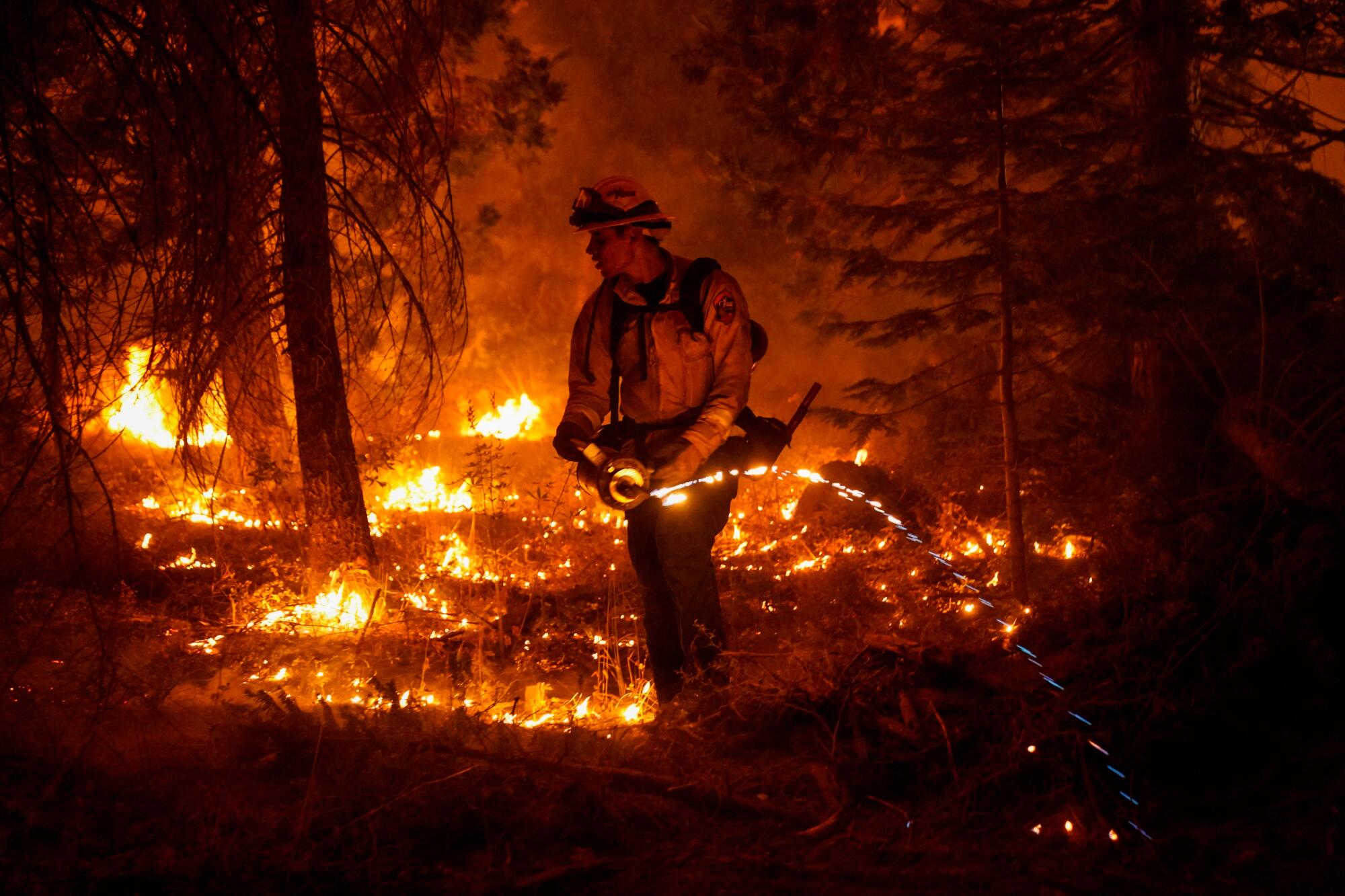
But wildfires will play out differently across the state depending on the landscape, said Max A. Moritz, a UC Cooperative Extension wildfire specialist. Fire-stoking Santa Ana winds will play a role in Southern California too, but just how a warming climate might change them remains a question, he said.
Some experts have criticized policymakers for focusing too much on wildfire response rather than prevention and limiting community exposures to fire hazards. Those responses could include avoiding building in the most fire-prone areas and buffering neighborhoods with parks or agricultural lands, Moritz said.
New technology developed by UCLA engineering faculty seeks to remove carbon dioxide from the ocean as a way to slow down climate change.
California has made efforts to prepare for worsening wildfires. Newsom’s 2021 $15-billion climate change package included $1.5 billion for wildfire response and forest resilience.
Nonprofits like the Climate and Wildfire Institute are connecting the science community to decision-makers in an effort to address megafires. There’s also been a push for databases and tool kits — a set of resources for local governments and communities — that support climate resilience-planning efforts. But they tend to be fuel-oriented and derived from a forested-landscape mentality, Moritz said, and those don’t work well in shrub-lands and other non-forested areas.
“For Southern California, we have a different set of mitigation measures that need to rise to the top, and we’re still moving along that path,” he said.
Sea level rise
The California coast is disappearing. Melting glaciers, ice sheets and ocean water expansion from warming are causing the sea to rise, and the Golden State is particularly vulnerable, with nearly 70% of the population living in coastal areas.
In the next three decades, sea level rise on the West Coast is expected to be between 4 and 8 inches, according to the most recent Sea Level Rise Technical Report.
Projections beyond that are uncertain and will depend on emissions reductions and how quickly ice sheets respond to warming, said Patrick Barnard, research director at the U.S. Geological Survey’s Pacific Coastal and Marine Science Center in Santa Cruz. But data show it’s accelerating. “We’ve more than doubled the rate of sea level rise over the last decade compared to the sort of more historical past,” he said.

Some projections warn that without massive human intervention, up to 67% of state beaches could completely erode by 2100. Transportation infrastructure such as airports and highways will be susceptible to flooding from storm surges and sea level rise, or both, without protective measures.
Sekich from the Surfrider Foundation said that California, like the rest of the country, is falling short on “proactive adaptation planning. Looking at roads that need to either be elevated or relocated. Infrastructure that is just chronically in a repetitive flood zone, and dealing with that,” she said. “I feel like we’re not looking at long-term solutions. We’re just looking at Band-Aid approaches.”
But Sekich added that the state is ahead of the curve when it comes to greenhouse reductions and implementing nature-based solutions, such as reviving dunes, which could act as natural flood protection from sea level rise and storm surges. “That’s the beauty of it: We’re leveraging the power of nature to protect nature. And that’s a pretty hopeful thing.”
Drought
Climate change is increasing the frequency, intensity and duration of California droughts. Warmer temperatures are enhancing evaporation, which dries out soils and plants, and reduces surface water. This will lead to drier seasonal conditions and contribute to water scarcity.
Rising temperatures are also reducing Sierra Nevada snowpack — a natural reservoir that traditionally supplies California with a third of its water. With more precipitation falling as rain instead of snow, and as snow melts more quickly, that supply of stored water will shrink. Some projections estimate that by the end of the century, California’s snowpack will plummet by 48% to 65%.
And some scientists have projected that the Colorado River, which serves about 40 million people, could lose about one-fourth of its flow by 2050 as the climate gets hotter and drier.
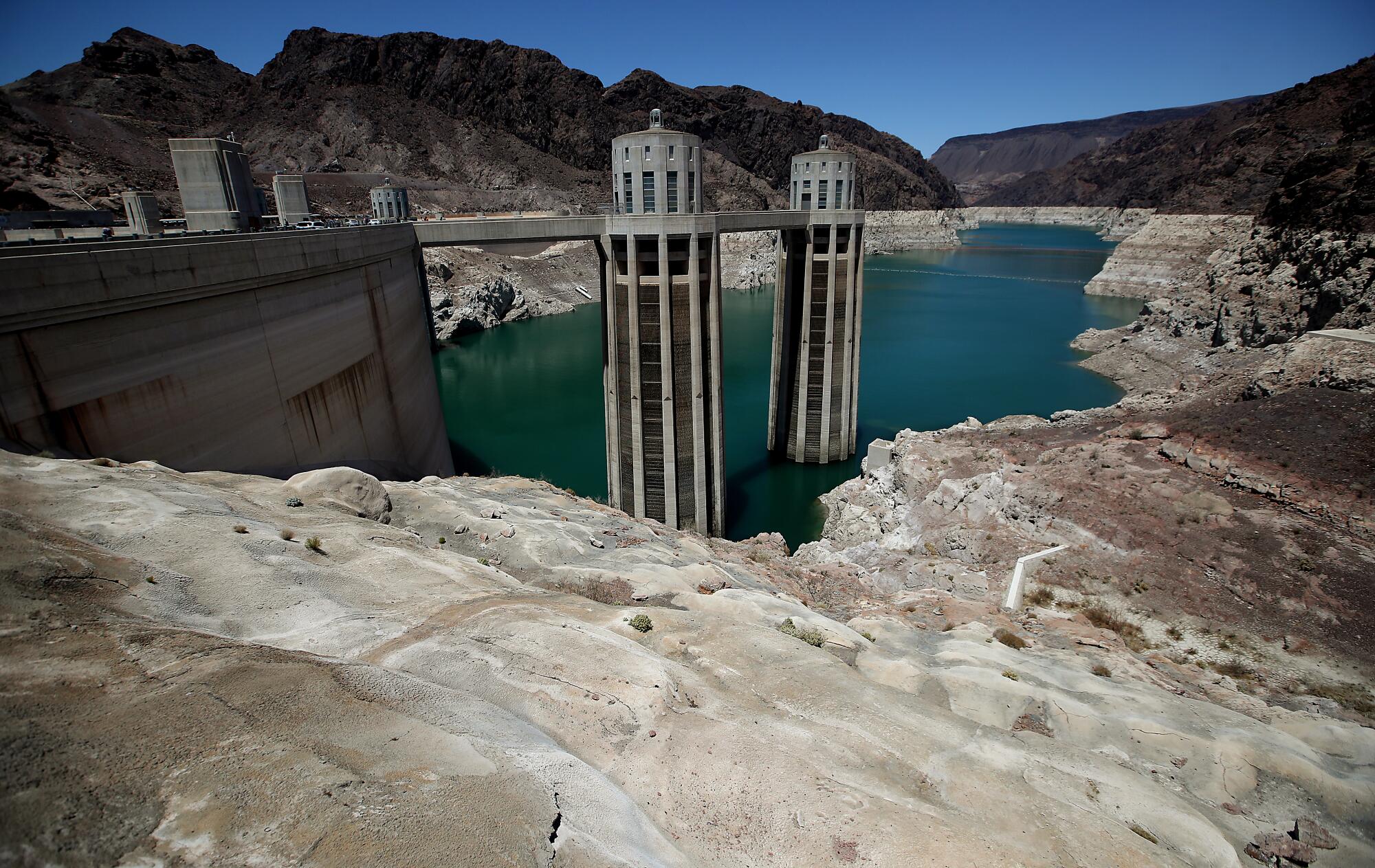
Nicola Ulibarri, associate professor in urban planning and public policy at UC Irvine, said among the biggest challenges in preparing for drought is “short-term memory.” Her research has found that people think about and deal with drought during dry years, but “it immediately falls off as soon as the water has come back,” she said.
Americans keep saying they care about climate. So why aren’t politicians doing more?
But she said California’s efforts to diversify its water supplies is a good step toward managing and preparing for longer, more intense and more frequent dry periods. “Instead of relying on one or two sources they’ve always had, [California is thinking]: How can we think about building out our recycled water capacity? Or how could we think about … water-bank type situations so that they can use water when it’s available, but then store some of that extra water for future years.”
Flooding
Projections indicate that global warming is also contributing to more intense wet periods and heightening the whiplash transition between periods of extended drought and intense precipitation.
One study projects that by the latter part of the century, extreme storms could bring 200% to 400% more runoff in the Sierra Nevada because intense precipitation will fall as rain rather than snow. Researchers say such conditions will increase the risk of megafloods — inundations equivalent to California’s Great Flood of 1862, which killed thousands and formed a vast inland sea hundreds of miles long.
Although climate researchers point out that this year’s storms were not the worst in California’s history, they do offer a glimpse of the destructive floods scientists have warned about.
By 2072, experts predict that peak flood flows in the Central Valley will increase up to five times compared with historical records, according to a recent flood protection plan for that area. Future flooding would threaten millions of Californians and cause widespread death and damage. The destruction could be as high as $1 trillion. Without adequate investments in infrastructure and other projects, massive floods could lead to more than 500 deaths annually in the Central Valley by 2072.
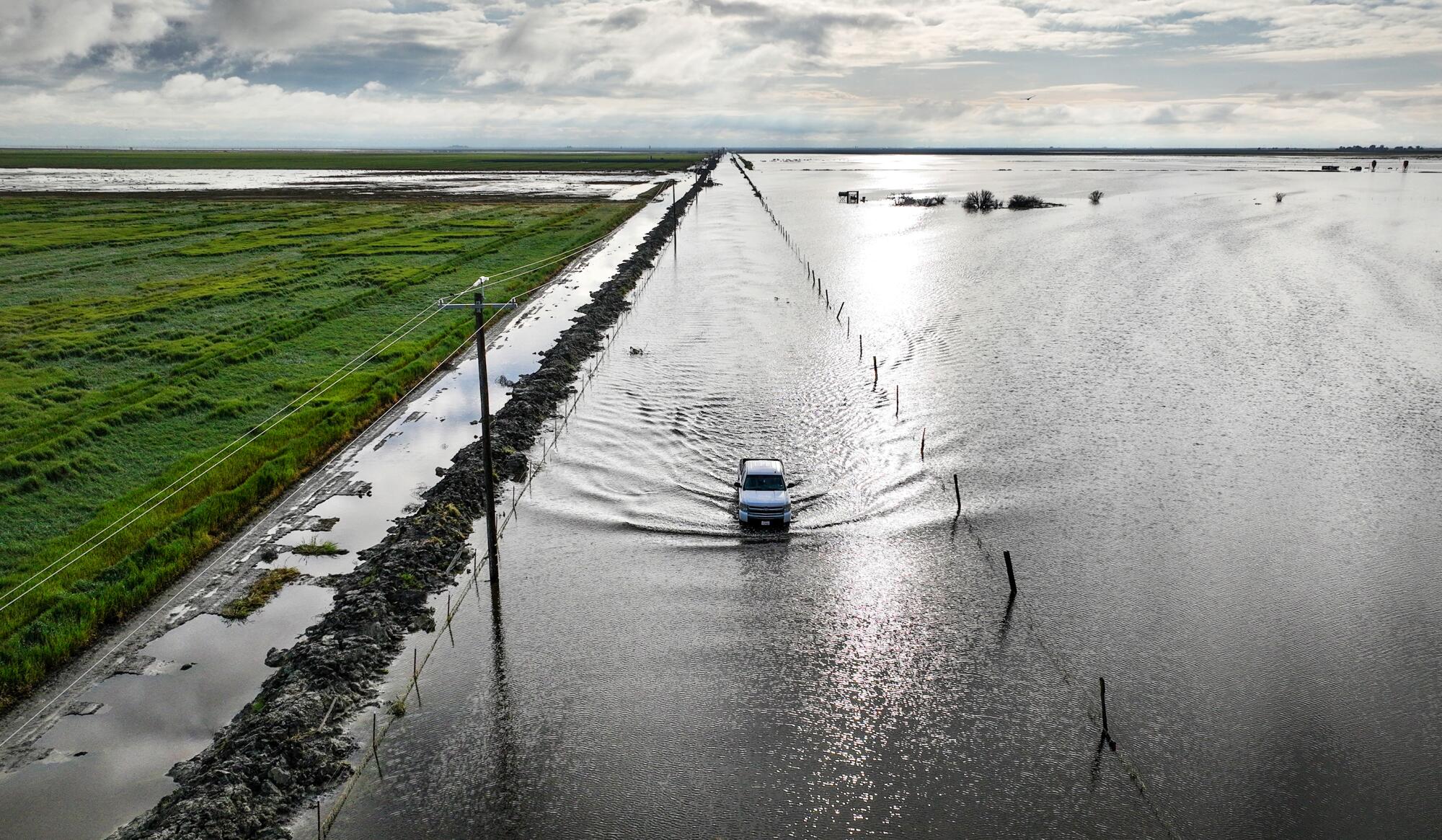
The Central Valley Flood Protection Plan hopes to avert those scenarios. The plan calls for $25 billion to $30 billion in investments over the next 30 years for infrastructure upgrades, emergency preparation and floodplain restoration.
But experts have said that modeling where floodwaters might go, how deep and for how long is essential to how well-prepared California will be for an Atmospheric River 1,000 Storm, or ARkStorm, a severe winter-storm scenario that would ravage the state.
Hope
Envisioning the future is scary. A recent poll found that the majority of Californians are increasingly worried about the state’s changing climate. Another survey found that most Americans are feeling the same way.
Sarah Dryhurst, an assistant professor at the Institute for Risk and Disaster Reduction at University College London, explained that fear is necessary to spur action. But in the long term, it can shut people down, so it needs be paired with another feeling.
“One of the emotions that is really useful to keep hold of is this feeling of hope ... to take action on something we need to feel a sense of threat, but we also need to feel a sense that we can do something and make a difference,” she said.
It remains to be seen if California, and the world, will be able to prevent the worst-case climate change scenarios. The United Nations’ most recent climate report warned that humanity is not acting at the necessary pace and scale, but it says we still have a chance if urgent action is taken. It says there is still hope.
Ask a Reporter: Inside the project
What: Times reporters Rosanna Xia and Sammy Roth will discuss “Our Climate Change Challenge” during a live streaming conversation. City Editor Maria L. LaGanga moderates.
When: Sept. 19 at 6 p.m. Pacific.
Where: This free event will be live streaming. Sign up on Eventbrite for watch links and to share your questions and comments.
More to Read
Sign up for Essential California
The most important California stories and recommendations in your inbox every morning.
You may occasionally receive promotional content from the Los Angeles Times.


